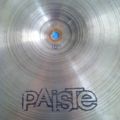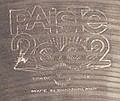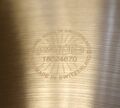Paiste Serial Numbers
Paiste serial numbers were first applied during 1972. Prior to this there was no accurate means of determining the age of a Paiste other than to identify the years of production for the series or model, when known.
These cymbals are referred to as "Pre-Serial" cymbals.
It should also be noted that it is not uncommon for serial numbers to be difficult to read due to hammering and lathing. In these cases, the era of the cymbal can usually be identified, but the exact year may not be determined.
Also of important note, cymbals have been found without serial numbers stamped on them from production eras where we might expect them.
This guide does not apply to serial numbers on many prototypes, nor the German made Paistes which seem to have been numbered from 1xxxxx up. The inclusion of German made Paistes may be why some people are sure they have Paiste cymbals with 6 digit serial numbers starting 1.
1972 - 1981
- Starting some time during 1972 there were six digit numbers stamped on each cymbal.
The specific year is identified by the 'first' digit in the serial number. Some believe a leading 1 means 1971, but we haven't found one having checked thousands.
All 6 digit serials with a leading 1 check out as 1981 for Swiss made cymbals. The German made ones do have leading 1, but that isn't the year* (see explanation below).
(*Old German-made Paiste's do have serial numbers from the early 70s onwards just like the Swiss cymbals. They used a different system than the Swiss system.
The first digit does not equal the year, they are numbered consecutively. If you are looking at a German Black Label Paiste from the 1970s, the second digit is a good general indicator of the year.
I.E. a German 2002 with a 17xxxx serial is from 1977 or 1978. In this case, a lower third digit most likely = 1977 while a higher third digit puts you closer to 1978.)
- Therefore, "345678" would be a cymbal manufactured in 1973.
- The original 1970's style involved no additional lettering with the serial number such as series name.
- Research is starting to show that Paiste Nottwil put serial numbers on the lower lines in 1972 and 1973 (at least some of the time) and then stopped this practice in very early 1974, choosing only to put serial numbers on the professional lines (F602, 2002 and later Sound Creation) for the rest of the Black Label era.
- All series (except Paiste 101) were using black labels during this era.
- 1972 Formula 602 Serial.jpg
1972 Formula 602
- 1974 2002 Serial.jpg
1974 2002
- 1977 2002 Serial.jpg
1977 2002
- Often a series would have an engraving of the series name:
1981 - 1986
- Starting in 1981, "PAISTE" started to be stamped above the serial number, often along with SERIES. (NOTE: This change occurred not at the beginning of the year, but sometime during it - some examples of the previous style exist with 1981 serial numbers.)
- Like before, the first number indicates year - the following would be an example of 1982:
- Formula 602 was shortened to simply "602".
- Sound Creation was located under PAISTE, due to space limitations.
- The RUDE and Colorsound 5 names were NOT stamped after PAISTE.
- 1981 RUDE Serial.jpg
1981 RUDE
- 1981 Sound Creation Serial.jpg
1981 Sound Creation
- 1981 2002 Serial.jpg
1981 2002
- 1983 505 Serial.jpg
1983 505
- During this time Paiste changed label colors on some of their series. Formula 602 - Blue, 2002 - Red, 505 - Green, among others.
1986 - 1990
- Sometime during 1986 (probably when they launched all the new lines - 3000, 2000, 1000, etc.), "PAISTE" was stamped above the serial number, without series name.
- Like before, the first number indicates year - the following would be an example of 1989:
- 505 (discontinued by this time) and the 1000 lines both used green logos.
- 2002 and 3000 lines used red logos. The red ink on the 3000 series is a little darker color.
- Formula 602 and 2000 lines both used blue logos.
- 505 16 Crash.jpg
505
- 1000 18 Crash.jpg
1000
- 3000 20 Ride.jpg
3000
- 2000 16 Crash.jpg
2000
1990 - 1995
- Sometime in 1990 the company name was changed to the 'high/low' style" "pAisTe".
- Therefore "pAisTe 345678" would be from 1993.
1995 - 2011
- Sometime in 1995 Paiste started using eight digit serial numbers. In these cases, the first two digits represent the year of production.
- Therefore "96789012" would be from 1996.
- 1995 Signature Serial.jpg
1995 Signature
- 1999 Signature Serial.jpg
1999 Signature
- 2006 2002 Serial.jpg
2006 2002
- 2007 Signature Serial.jpg
2007 Signature
- Starting in about 2005, "MADE IN SWITZERLAND" was added to the bottom logo of the 2002 cymbals.
2011 - present
- In the second half of 2011, Paiste started using a laser etched serial number on the cymbal's bottom side. Numbers are not stamped on the top side from this point on. The first two numbers are still the year produced.
- 2012 Giant Beat Serial.jpg
2012 Giant Beat
- 2017 Giant Beat Serial.jpg
2017 Giant Beat
- 2018 Signature Reflector Serial.jpg
2018 Signature Reflector













































